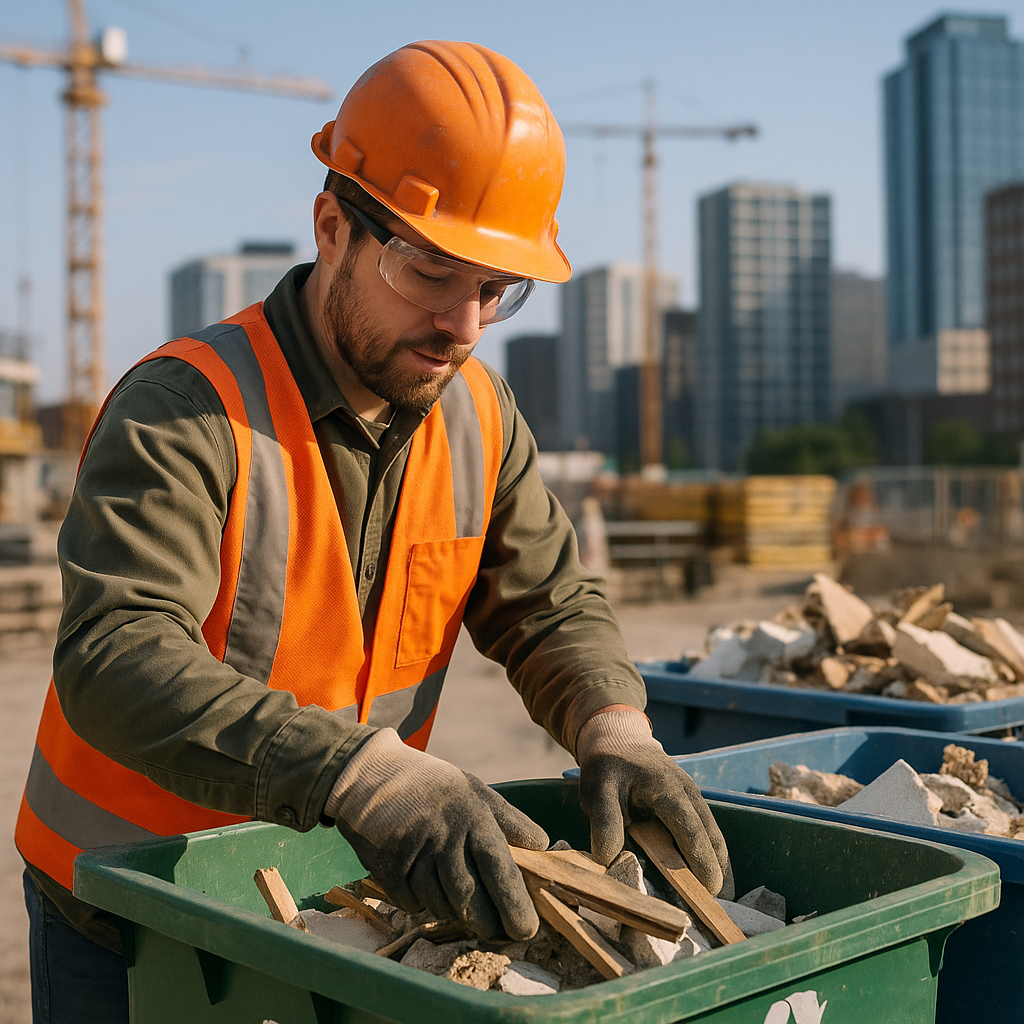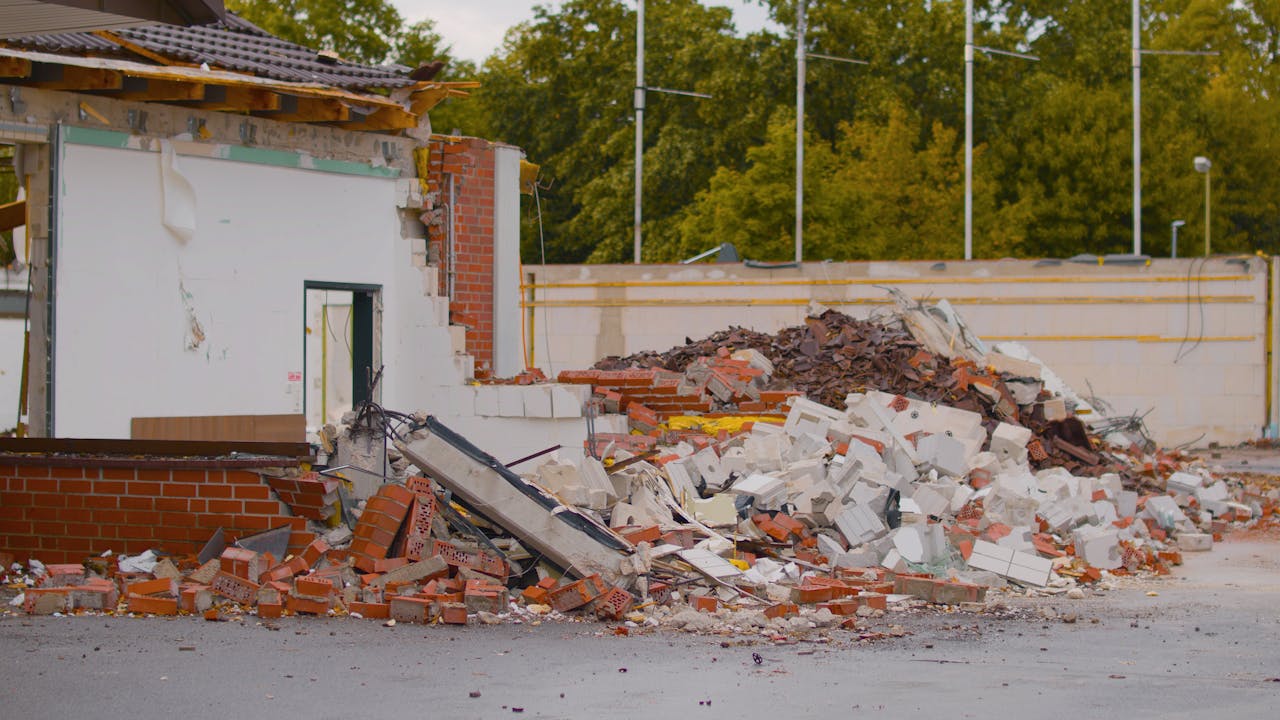5901 Botham Jean Blvd, Dallas, TX 75215
What Is C&D Waste? Key Facts and Management Tips
July 1, 2025Construction and demolition waste, often abbreviated as C&D waste, includes debris generated during construction, renovation, and demolition projects. These materials accumulate rapidly at construction sites nationwide, posing disposal challenges for contractors while raising environmental concerns in communities. C&D waste typically originates from structures such as buildings, bridges, roads, and other infrastructure projects.
The composition of C&D waste varies by project but generally includes concrete chunks, wood scraps, metals, bricks, glass, drywall, asphalt, and plastics. These bulky, heavy components make C&D waste particularly challenging to transport and process. Many materials also contain potentially hazardous elements like lead or asbestos, especially from older building demolitions.
Industry estimates suggest that C&D waste accounts for 15-20% of the total municipal solid waste stream in many regions. This substantial volume underscores the importance of properly managing construction and demolition materials for environmental sustainability and resource conservation efforts.
Why is C&D Waste Management Important?

Landfills across the nation are nearing capacity, with many facilities expected to close within the next decade. This creates an urgent need for alternative C&D waste solutions. The decreasing landfill space presents both environmental and logistical challenges for the construction industry.
Improper C&D waste disposal impacts more than just landfill capacity. Illegal dumping poses immediate health hazards in communities, contaminating soil, polluting water, and significantly lowering property values. Municipal cleanup operations are costly, diverting funds that could be used in more beneficial ways.
Environmental protection is a key benefit of proper C&D waste management. Diverting materials from landfills reduces pollution and conserves natural resources. The extraction and processing of virgin materials for construction have substantial environmental impacts, which can be lessened through effective recycling practices.
Economic Benefits of Proper C&D Waste Management
On-site processing of C&D waste offers immediate financial benefits. Construction companies can significantly cut transportation costs by reducing the need to haul waste to distant facilities. This leads to savings in fuel consumption and labor hours.
The economic advantages extend beyond transportation. By managing waste on-site, companies lower disposal expenses through reduced landfill tipping fees, which continue to rise as landfill space becomes scarce, making waste diversion increasingly cost-effective.
Recycling construction materials unlocks new revenue opportunities. Reclaimed materials can be sold or reused in future projects, transforming what was considered waste into valuable resources. This practice supports a more circular economy in the construction sector.
Creating a More Sustainable Construction Industry
Effective C&D waste management aligns with broader sustainability goals in construction. Resource efficiency improves as materials are reused rather than discarded, helping conserve resources for future generations.
Companies that adopt comprehensive waste management practices enhance their market reputation. Increasingly, clients seek construction partners committed to sustainability. A proven commitment to responsible waste management can offer a competitive advantage.
The construction industry generates significant employment opportunities through proper waste management. Sorting, processing, and recycling activities require skilled workers, supporting economic growth while addressing environmental challenges.
[[artifact_table]] Economic and Environmental Benefits of C&D Waste Management [[/artifact_table]]Addressing C&D waste challenges requires a fundamental shift in how the construction industry views materials. Considering construction debris as potential resources rather than waste opens up new opportunities for innovation. This change in perspective can drive continuous improvement in waste reduction strategies.
What Are the Benefits of Recycling C&D Waste?

Recycling construction and demolition waste provides significant environmental and economic benefits beyond the construction site. According to EPA data, the United States generated about 600 million tons of C&D debris in 2018—more than twice the amount of regular municipal solid waste. Without proper management, this material burdens landfills and wastes valuable resources.
Recycling C&D waste offers both immediate and long-term advantages:
- Landfill Conservation – C&D waste accounts for roughly 30% of all landfill waste. Recycling these materials reduces the need for new disposal spaces and extends the lifespan of existing facilities.
- Environmental Protection – Recycling lessens the need for raw material extraction, meaning reduced mining, quarrying, and logging, and helping preserve natural habitats while cutting pollution.
- Carbon Footprint Reduction – Manufacturing new construction materials generates significant carbon emissions. Recycling reduces the carbon cost of producing these materials.
- Job Creation – The recycling industry generates employment in collection, sorting, processing, and manufacturing, contributing to local economic growth.
- Cost Savings – Contractors can achieve substantial savings through reduced disposal fees, lower transportation costs, and possible revenue from selling recyclable materials.
- Regulatory Compliance – Many regions now require specific recycling rates for construction projects. Recycling helps companies meet these requirements and avoid penalties.
The economic benefits are particularly compelling. Construction companies can save between $8-$12 per ton by recycling concrete rather than sending it to landfills. For large projects, these savings quickly add up.
Common C&D materials have specific recycling applications:
Concrete, a prevalent C&D material, can be crushed for use as aggregate in new projects, road bases, or drainage systems. Wood waste can be processed into mulch, biomass fuel, or reclaimed for new construction. Metals can be melted down and reformed indefinitely. Asphalt from demolition sites can be reused in new pavements, reducing the demand for new materials.
Beyond traditional recycling, deconstruction—careful dismantling of buildings to salvage materials—offers an increasingly viable approach. This method preserves valuable resources and provides additional cost benefits through material recovery.
By implementing comprehensive recycling practices, construction professionals contribute to environmental sustainability and improve their bottom line through operational efficiencies and resource optimization.
How Can C&D Waste Be Managed Effectively?
Effective C&D waste management requires a multifaceted approach that combines policy, infrastructure, and education. Local governments and construction industry stakeholders can adopt various strategies to maximize diversion from landfills.
C&D diversion ordinances have proven highly effective in many jurisdictions. These laws authorize the enforcement of required diversion activities. To develop such ordinances, it is essential to understand local waste streams and the existing recycling infrastructure before setting diversion requirements.
Most successful C&D diversion ordinances include waste management plans (WMPs) as a requirement. These plans estimate the C&D debris a project will generate and outline how materials will be managed. Contractors must consider the amount of waste they will produce and plan appropriate diversion methods before work begins.
Setting appropriate thresholds is critical for the effectiveness of an ordinance. Thresholds determine which projects must comply with diversion requirements based on size, cost, or project type. Some jurisdictions target large commercial projects first, then gradually expand to include smaller residential projects as recycling markets develop.
The California Green Building Standards Code (CALGreen) provides a helpful benchmark, requiring at least 65 percent diversion of C&D waste from most new construction projects. Local ordinances can exceed this requirement but must meet this minimum standard.
On-site material sorting significantly improves recycling outcomes. Successful projects implement clearly marked bins for different material types and provide frequent worker training on proper sorting techniques. Contamination remains one of the biggest challenges to effective recycling.
Strong partnerships with local recycling facilities create smooth pathways for materials. These relationships should include clear communication about acceptable materials and preparation requirements. Some jurisdictions have developed certification programs for C&D recycling facilities to simplify compliance verification.
Education forms the backbone of any successful C&D waste management program. Contractors need information about available diversion facilities, cost comparisons between recycling and disposal, and proper sorting techniques. Building departments should provide handouts and website resources detailing local options.
Material reuse and deconstruction offer additional diversion opportunities. Rather than demolishing structures, careful dismantling can salvage valuable components. Encouraging deconstruction before demolition maximizes material recovery and can count toward diversion requirements.
Performance deposits serve as financial incentives for compliance. Contractors submit deposits before project commencement, which are returned upon verification of meeting diversion requirements. This approach has proven effective in many jurisdictions.
Implementation Strategies for Contractors
For contractors working in areas with C&D diversion requirements, early planning is essential. Review local ordinances to understand specific thresholds, documentation requirements, and acceptable facilities before bidding on projects.
Allocate adequate space on job sites for material sorting and storage. This planning must happen before construction begins. The temporary storage area should be easily accessible to workers and hauling vehicles.
Train all site personnel on waste management procedures. Even the best-designed program will fail if workers don’t understand where materials belong. Regular reinforcement of these practices throughout the project maintains compliance.
Document all material movement meticulously. Weight tickets, gate receipts, and invoices from recycling facilities serve as critical evidence of compliance when submitting final reports. Keep records organized by project and material type.
Consider using specialized waste management companies familiar with local requirements. These services can handle sorting, transportation, and documentation, simplifying compliance for contractors who lack expertise in this area.
Benefits Beyond Compliance
Effective C&D waste management delivers significant benefits beyond meeting regulatory requirements. Reduced disposal costs often offset the expense of implementing recycling programs. As landfill tipping fees continue rising, this financial advantage grows more pronounced.
Demonstrating environmental responsibility enhances company reputation and can create competitive advantages when bidding on projects with sustainability requirements. Many clients now prioritize contractors with proven waste diversion track records.
Using recycled C&D materials in new construction projects closes the materials loop. This practice reduces demand for virgin resources while creating markets for recovered materials. Common applications include using crushed concrete as aggregate and incorporating salvaged architectural elements.
Diverting C&D waste from landfills significantly reduces greenhouse gas emissions. Construction materials in landfills produce methane as they decompose, while the manufacturing processes for new materials generate substantial carbon emissions.
Although implementing effective C&D waste management practices requires an initial investment in planning and infrastructure, the combined environmental, economic, and reputational benefits make it worthwhile for construction industry stakeholders. As regulations tighten and disposal costs rise, these practices will become increasingly standard across the industry.
Conclusion: The Future of C&D Waste Management
The construction industry is at a critical juncture in waste management practices. As global construction activities increase to meet the demands of growing populations, the volume of construction and demolition waste is rising significantly. Effectively managing these materials is vital for environmental sustainability and resource conservation.
Smart technologies, innovative sorting methods, and advanced recycling processes are transforming how we handle C&D waste. These developments, along with comprehensive waste reduction strategies and circular economy principles, offer promising solutions to minimize environmental impact while maximizing resource recovery. Achieving more sustainable construction practices requires continued investment in education, stronger policy frameworks, and technological innovation.
For your construction and demolition recycling needs, contact Okon Recycling at 214-717-4083. Our expert team can help you implement effective waste management solutions that support both your project goals and environmental commitments.
